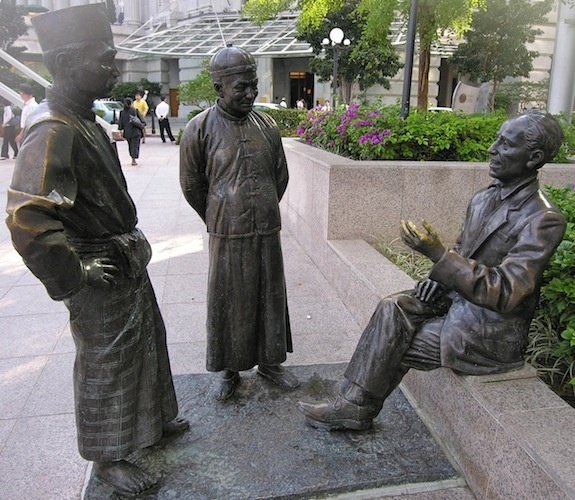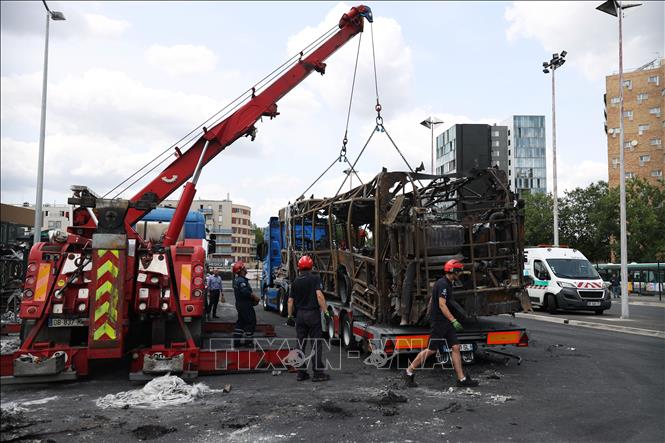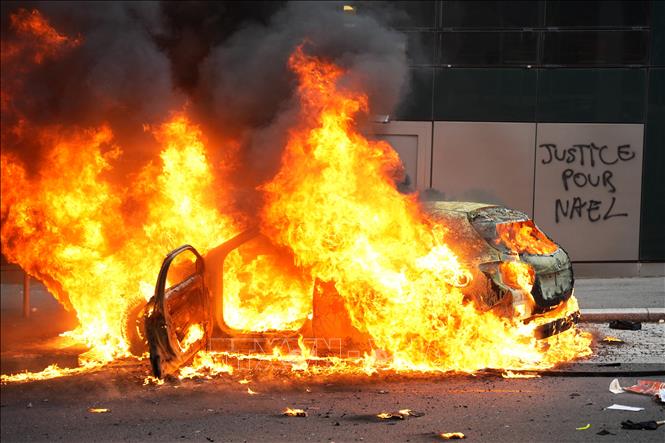Copy bản full không che bài báo Bloomberg cho cụ nào không vào được Bloomberg. Có thể dùng Google translate để dịch
Bloomberg: Riots in France Expose Decades of Failure in Tinderbox Suburbs
Bạo loạn Pháp phơi bày thất bại trong nhiều thấp kỷ tại các khu vực ngoại ô, thị trấn nhỏ của "dân lao động" ("tinderbox" là hộp đồ nghề của dân lao động)
Angry and disillusioned youth in the banlieues and an increasingly ill-trained police force have created an explosive situation
Riot police face protesters during clashes in Nanterre, near Paris on June 29.
Riot police face protesters during clashes in Nanterre, near Paris on June 29.Photographer: Christophe Ena/AP Photo
ByAnia Nussbaum, Tara Patel and William Horobin+Follow
6 July 2023 at 11:00 GMT+7
As fierce clashes burst out last week in France’s worst riots in nearly two decades, protesters set buses on fire and charred the facade of a swimming pool being built for the 2024 Olympics in Aubervilliers, a working-class suburb north of Paris near where Emmanuel Macron first declared he was running for president.
There was a reason why Macron had picked the area to announce his candidacy in 2016. His speech, sprinkled with a pledge “to act and protect the weakest” with jobs, was yet another attempt by a French presidential hopeful to address one of the country’s most intractable problems: the seemingly unbridgeable social and economic chasm separating the residents of impoverished suburbs from the rest of France.
Over the decades, hundreds of blighted French towns like Aubervilliers, with large migrant populations, poverty, high youth unemployment, overcrowded public housing, and in some cases gangs and drugs, have been targeted for improvement by French leaders. One recent effort included locating athletic Olympic facilities in several of them. But the broader failure of successive plans, and a breakdown in the residents’ trust in state institutions, from the police to mayors, have turned such suburbs, or banlieues as the French call them, into tinderboxes.
“The strategy of governments has been to invest as little as possible to try to prevent a blow up,” said Hakim El Karoui, a fellow at the Paris-based Institut Montaigne think tank. “At no time have they tried to actually fix the problems.”
France Protests
A vehicle burns during clashe between protesters and police in Nanterre.Photographer: Benjamin Girette/Bloomberg
The spark for the latest explosion of rage was the fatal shooting — caught on video — by a police officer of Nahel, a 17-year-old boy of North African descent in Nanterre, another Paris suburb. For almost a week after the killing, images of youths burning cars, clashing with the police, pillaging stores and setting fire to public buildings from town halls to schools made their rounds on TV screens across the globe.
They evoked comparisons with the riots after the 2020 killing of George Floyd in the US and the 2011 clashes in London, also after a police shooting, and reignited debate over the confluence of perceived racism, brutal law enforcement, crime and poverty in pockets of the world’s advanced economies.
Still, the conflagration is a very public and painful sting for France, the country of “liberté, égalité, fraternité” where the state’s commitment to remaining colorblind extends to bans on collecting data based on race and ethnicity. The episode is also fueling support for the anti-immigrant far-right leader Marine Le Pen, with a poll of 1,000 people by Elabe for BFM TV showing that her political standing has benefited the most from the riots. A crowd-funding effort to support the policeman’s family sponsored by an ultra-rightwing politician has raised more than €1.6 million ($1.74 million), while that for Nahel’s raised about €442,000.
In the immediate term, France is counting the cost of the riots. French insurers have so far received about 5,900 claims worth a total of some €280 million, according to Florence Lustman, chair of industry lobby France Assureurs.
France Protests
Police guard the burned Hotel du ville in Garges-les-Gonesse, north of Paris.Photographer: Stefano Rellandini/Getty Images
The events have also once again turned the spotlight on the deeper problems of these areas, sparking the same kind of soul-searching as in 2005 when riots raged for weeks after two boys died in Clichy-sous-Bois following a police chase.
The banlieues, built to house workers in the 1960s and 1970s, began attracting immigrants over the years and have become bywords for deprivation and tensions around race and ethnicity.
“Working-class neighborhoods in France that have for decades been abandoned or suffered from bad policies won’t be rebuilt in three years,” Government spokesman Olivier Veran said on France Inter radio on July 2, adding that it takes generations to emerge from poverty.
To get a measure of the challenge, the country drew up a list in 2014 of some 1,500 “priority” neighborhoods, based on income and the assessment of local officials. As of 2020, they housed about 5.4 million people, or about 8% of the country’s population.
France's Poorest Suburbs Are Younger, Overcrowded
Over the years, successive governments have conceived a head-spinning number of plans to reduce poverty and unemployment and improve education and well-being. The national auditor Cour des Comptes estimated in a 2020 report that the government spends about €10 billion a year to close the gap between priority areas and the others. This doesn’t include the hundreds of millions more spent on construction and renovations and expenditures by local authorities, it says, adding that the total amount expended and the efficacy of the programs are hard to determine.
According to a study published last year by the Institut Montaigne think tank, there’s an annual shortfall of €1 billion in spending on things like education and justice in these places.
On balance, much of the investment in the last two decades has gone into replacing towering, cramped housing blocks with smaller, more human developments, according to Stéphanie Vermeersch, a research director at France’s Institute of Humanities and Social Sciences. That focus, she says, has left blind spots in education, job discrimination and police relations.
“There are clearly neighborhoods that look nothing like what they used to,” Vermeersch said. “But the fundamental problem is that the social reality hasn’t changed.”
Unemployment Rates Double in Poorest Suburbs
In fact, a great deal of the focus in the last several years has been on more and tougher policing. An angry, disillusioned, disenfranchised youth population facing an increasingly ill-trained police force has created an explosive situation. The national auditor in 2022 warned of a “major risk” of declining skills within France’s police force and called for an urgent plan to remedy dysfunctional on-the-job training programs.
The UN High Commissioner for Human Rights criticized France over the killing of Nahel, calling on the country to “seriously address the deep issues of racism and discrimination in law enforcement,” charges the government vehemently denies. Interior Minister Gerald Darmanin told Senators Wednesday that France could do better in recruiting and training officers including on the shooting range.








 .
.